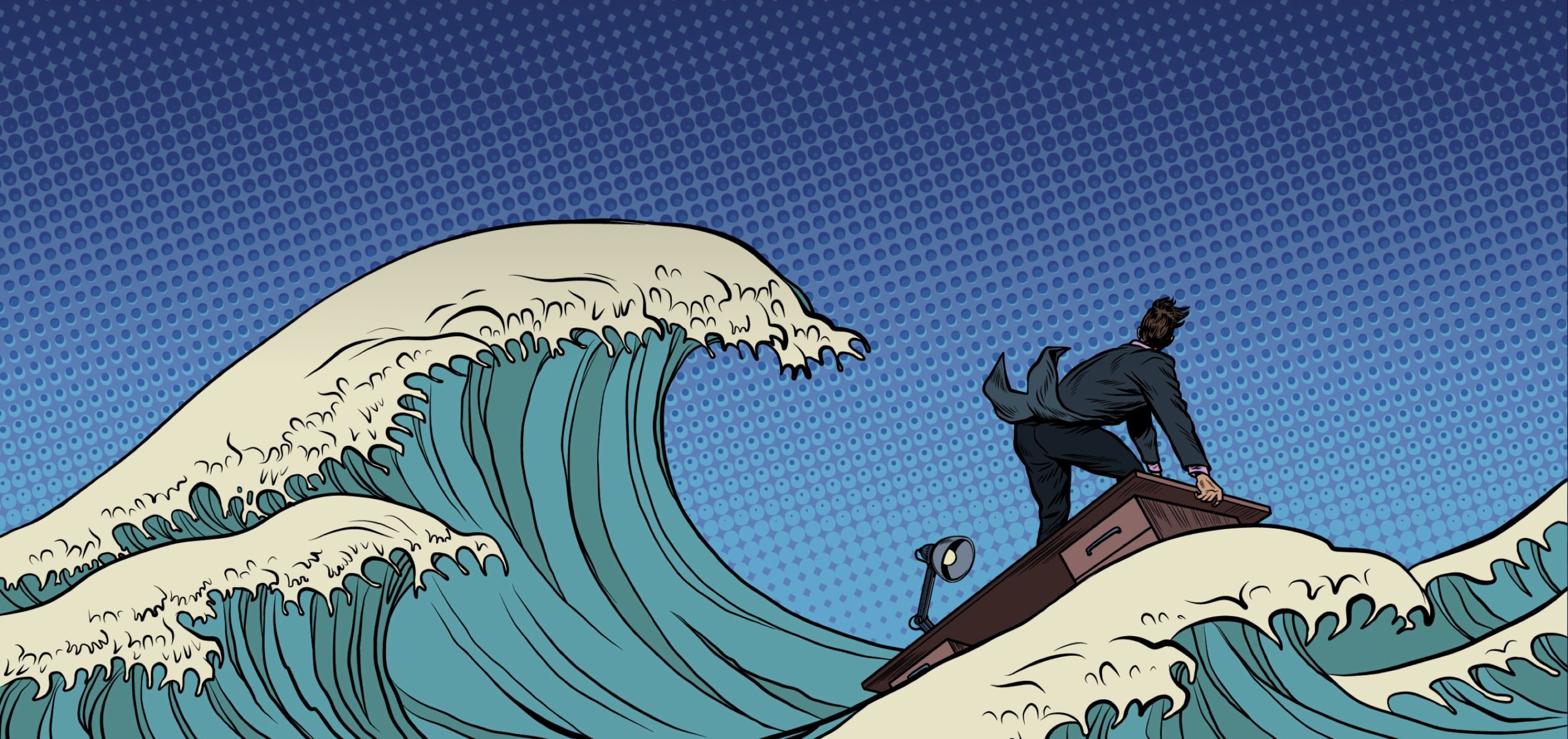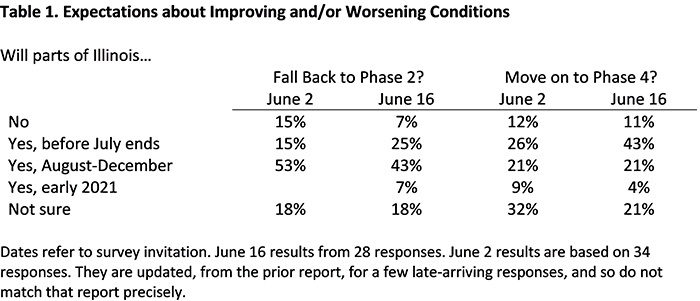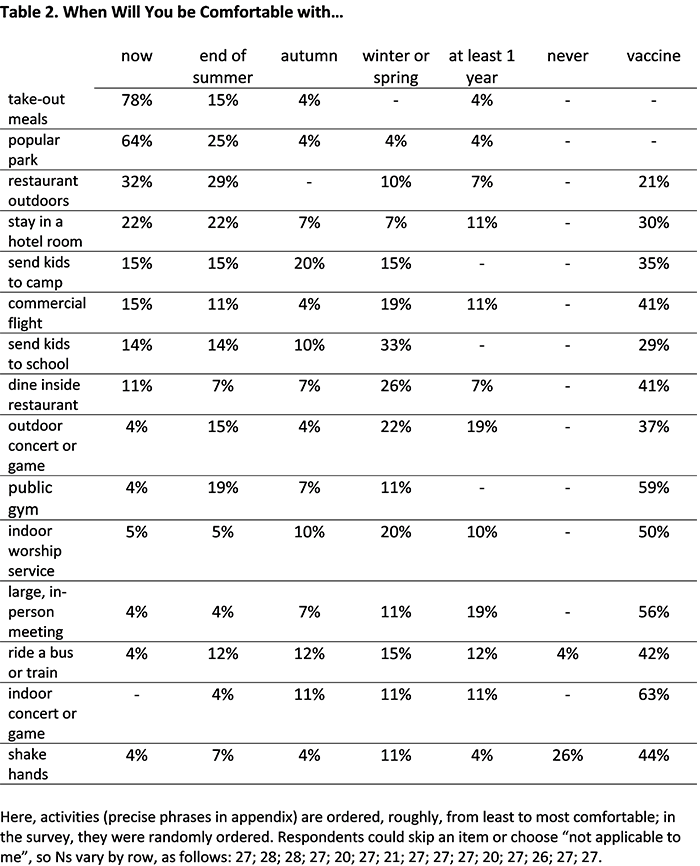
The University of Illinois System’s Institute of Government and Public Affairs (IGPA) is developing several Pandemic Stress Indicators, designed to evaluate the social and economic effects of the COVID-19 pandemic on Illinois residents. The Pandemic Stress Indicators grew out of the work on IGPA’s Task Force on the Impact of the COVID-19 Pandemic.
This first stress indicator is a frequent poll of three sets of experts about pandemic policies. Experts on economics, public health, and/or vulnerable populations from across Illinois have generously agreed to provide regular opinions on various pandemic policies. The panelists, with affiliations, are listed in Appendix A, as are exact question wordings.
IGPA invited about 50 experts to our new survey on June 16. We are grateful to have received 28 responses. In answering the surveys, all panelists provide only their own personal views, and do not offer official positions on behalf of their respective institutions.
Next step forward, or back?
On June 2, as we sent out the second wave of the survey, most of Illinois had just shifted from Phase 2 (“Flattening”) to Phase 3 (“Recovery”). We asked the experts if (when) they expected further transitions, either a welcome jump to Phase 4 (Revitalization) or a regrettable slip backward to Phase 2. We repeated these questions in wave 3, to see if expectations appear to be shifting at all as June moves along.
Table 1 shows that changes were not dramatic, but our sample, as a whole, was a little more pessimistic about some parts of the state slipping back, with a quarter (7/28) now thinking this will happen soon, before July is out. Interestingly, the sample was also somewhat more inclined to predict some near-term improvement, with more than 40 percent now predicting that parts of Illinois will fairly soon enter Phase 4, with its looser restrictions, due to better public health outcomes.
There is no inconsistency or irony in these results. Because the current Illinois policy is to classify distinct regions separately, the implication is that our experts are increasingly expecting wider gulfs in outbreak severity between different parts of the state.

Life in Phase 3
In early June, we asked the panel to evaluate some of the new, slightly looser rules about day-to-day life in this phase of the outbreak. We also repeated that question, to see if a little bit of experience with the new rules seems to have altered judgments.
In short, the answer was “no, their views have not changed.” In early June, large majorities thought that the seven provisions we noted (gatherings of 10 or fewer permitted; youth sports practices held, without games; hair-care facilities, non-essential businesses, and outdoor dining open, with certain restrictions; and remote learning for P-12 plus limited child care) were sensible. Only the then-new option to hold indoor worship services, with guidance rather than rules, struck the panelists as “not restrictive enough” (25/34=74%).
The mid-June view is essentially the same, with 22/28 (79%) taking that same view, and similar shares dubbing all of the other rules “sensible.”
Personal activity decisions
In this wave, we introduced a question asking experts about their comfort level with a variety of previously normal, but now possibly risky activities. Instead of characterizing their views of state policies, they gave us their own feelings about when they expect to be comfortable with such everyday actions as eating out, riding a bus or mixing with crowds at an indoor concert.
Table 2 shows the fifteen activities we broached, roughly ordered from highest to lowest comfort levels. (The table’s row labels are abbreviated— exact question phrasing can be found in the appendix.) For each, respondents could indicate that they are already “personally comfortable” with the particular action, expect to be comfortable by the end of summer, by the autumn, in the winter or early spring, or at least a year from now. They could also choose “never.”
Of course, forecasts about future comfort depend on guesses about how the pandemic will proceed in the intervening period. One person saying that (s)he expects to be content to do something in the autumn might have in mind a very different expected set of autumn outcomes (confirmed cases, recent deaths, hospital capacities, etc.) than another. To try to pin down such conditions a little, we also offered the option of “only when there is a proven vaccination program.” Finally, since some of these choices might be inapplicable to given experts, according to their family circumstances or pre-pandemic routines, we invited them either to skip particular activities or, if they preferred, answer hypothetically (e.g., “if I did have school-aged children…”)
At one end of the spectrum, the majority of our experts are already fine with take-away restaurant meals. The only other activity with a majority saying that they are already comfortable was “(to) walk or run through a popular park.” For every other activity, between one fifth and nearly two-thirds of respondents said that they’re waiting for a vaccine. It seems that indoor activities arouse much more anxiety, but even being outdoors is not seen as sufficient protection for many of our respondents when an activity involves crowds (e.g. attending a concert or sporting event).
The “never” option was almost completely ignored, except for the only essentially symbolic action on our list, “shaking hands with a stranger.” Most respondents said they’ll be OK with doing that once there is a vaccination program, but a quarter would seemingly prefer to dispense forever with the practice.
Our respondents are not a simple random sample of the general public, and so Table 2 cannot be read as a dire forecast for the near-term future of concerts, spectator sports, mass transit and so on. But the wariness of these experts does suggest that activities where maintaining personal distance is difficult, even outdoors, are worrying to those professionally oriented to public health. The contrast between our experts on economics and experts on public health or vulnerable populations, noted in prior reports, shows up a little in these responses, but in most cases, the separation was not dramatic.
Knowing that survey questions are potentially frustrating for respondents, if their desired answer is not on offer, we invited our experts to elaborate on how they interpreted these questions. Some stipulated that their behavior is, and will continue to be, heavily contingent on others using face coverings, obeying social-distance guidelines and so on. Thus, a few respondents explained their not-very-soon answers as following from noticing poor compliance with regulations and guidance in their areas. Reckless behavior by others breeds extra caution.
On the other hand, having flown commercially for an emergency, one respondent reported that (s)he felt safe because the plane was only about one-third full. In turn, (s)he has become more open to future flying. Another indicated that a positive experience with well-spaced restaurant dining in another state had been reassuring, and affected his/her answer to the dining questions.

Appendix
Most of Illinois has just shifted to Phase (Recovery) under the Restore Illinois plan, based on data pertaining to COVID-19 cases and medical capacity, plus testing and tracking capacity. Do you think the following Phase 3 provisions, easing previous restrictions, are sensible, not restrictive enough, or too restrictive? (If you are not sure what to think about a given rule, you can leave a row blank.)
too restrictive
sensible
not restrictive enough
Gatherings of 10 or fewer allowed.
Allow youth sports training with distance, but no games.
Allow outdoor seating at restaurants, with distance and caps on party size and total capacity.
Allow hair-care facilities to open, with masks, customer distance, and total-customer caps.
Non-essential businesses allowed to open with distancing and capacity restrictions
Remote learning in P-12 schools and higher education; limited child care and summer programs open with IDPH approved safety guidance
Allow indoor worship services, with guidance (not restrictions) on capacity, cleaning, and conduct
Do you think any part of Illinois will shift back to Phase 2 (Flattening), out of Phase 3 (Recovery), because of new outbreaks, increased positivity rate, or sharp declines in capacity?
Do you expect any part of Illinois to shift from Phase 3 (Recovery) to Phase 4 (Revitalization) because of improving data and/or modified criteria in the near future?
Please indicate when you expect to be personally comfortable with the following activities. If your answer is conditional on a proven vaccination program for COVID-19, you should choose the third last column. Otherwise, please base your answers on your current expectations about how the outbreak will progress. You can assume you would be taking whatever precautions you like (e.g. wearing a mask). If you are unsure, you can leave a row blank. If an activity is not applicable to your normal, pre-pandemic lifestyle, please choose the final column, but also feel free to answer hypothetically (e.g. "I don't have children of school age, but if I did....")
| already | by the end of summer | in the autumn | next winter or spring | at least a year from now | only when there's a vaccine | probably never | not applicable to me | |
|---|---|---|---|---|---|---|---|---|
| stay in a hotel room | ||||||||
| take a commercial flight | ||||||||
| send children to camp | ||||||||
| attend an outdoor concert or sporting event | ||||||||
| attend an indoor concert or sporting event | ||||||||
| attend an indoor worship service | ||||||||
| buy a take-out meal from a restaurant | ||||||||
| dine at a restaurant in outdoor seating | ||||||||
| dine inside a restaurant | ||||||||
| ride a bus or train | ||||||||
| work out in a public gymnasium | ||||||||
| walk or run through a popular park | ||||||||
| send children to school | ||||||||
| shake hands with a stranger | ||||||||
| attend a large, in-person meeting, lecture, seminar, etc. |
Experts in Pandemic Stress Indicator Panel
Evan Anderson, Northern Illinois University
Laurence Appel, University of Illinois at Chicago
Brandi Barnes, University of Illinois at Urbana-Champaign
Mark Daniel Bernhardt, University of Illinois at Urbana-Champaign
Mark Borgschulte, University of Illinois at Urbana-Champaign
Stephen Brown, University of Illinois at Chicago
Beverly Bunch, University of Illinois at Springfield
Patricia Byrnes, University of Illinois at Springfield
Lorraine Conroy, University of Illinois at Chicago
Toni Corona, Madison County Health Department
Michael Fagan, Northwestern University
Joseph M. Feinglass, Northwestern University
Barbara Fiese, University of Illinois at Urbana-Champaign
Lidia Filus, Northeastern Illinois University
Tamara Fuller, University of Illinois at Urbana-Champaign
Michael Gelder, Northwestern University
Robert J. Gordon, Northwestern University
Betsy Goulet, University of Illinois at Springfield
Jeremy Groves, Northern Illinois University
Bart Hagston, Jackson County Health Department
Marc D. Hayford, Loyola University Chicago
Ronald Hershow, University of Illinois at Chicago
Hana Hinkle, University of Illinois at Chicago
Joseph K. Hoereth, University of Illinois at Chicago
Wiley Jenkins, Southern Illinois University
Timothy Johnson, University of Illinois at Chicago
Greg Kaplan, University of Chicago
Sage J. Kim, University of Illinois at Chicago
Brenda Davis Koester, University of Illinois at Urbana-Champaign
Ken Kriz, University of Illinois at Springfield
Janet Liechty, University of Illinois at Urbana-Champaign
Justin McDaniel, Southern Illinois University Carbondale
Ruby Mendenhall, University of Illinois at Urbana-Champaign
Edward Mensah, University of Illinois at Chicago
Linda Rae Murray, University of Illinois at Chicago
Katie Parrish, Lake Land College
Sarah Patrick, Southern Illinois University Carbondale
Alicia Plemmons, Southern Illinois University Edwardsville
Carolyn A. Pointer, Southern Illinois University
Tara Powell, University of Illinois at Urbana-Champaign
Tyler Power, Quad Cities Chamber of Commerce
Elizabeth Powers, University of Illinois at Urbana-Champaign
Chris Setti, Greater Peoria Economic Development Council
Abigail Silva, Loyola University Chicago
Brian Smith, University of Illinois at Springfield
Tracey J. Smith, Southern Illinois University Springfield
Nicole M. Summers-Gabr, Southern Illinois University
Vidya Sundareshan, Southern Illinois University
James A. Swartz, University of Illinois at Chicago
Kevin Sylwester, Southern Illinois University Carbondale
Karriem Watson, University of Illinois at Chicago
Moheeb Zidan, Knox College
Because the current Illinois policy is to classify distinct regions separately, the implication is that our experts are increasingly expecting wider gulfs in outbreak severity between different parts of the state.